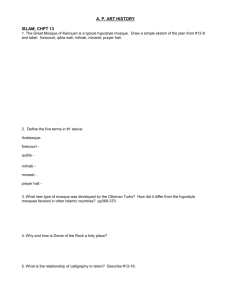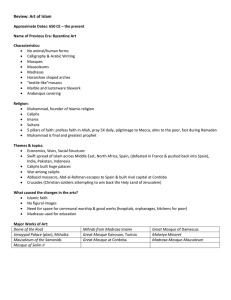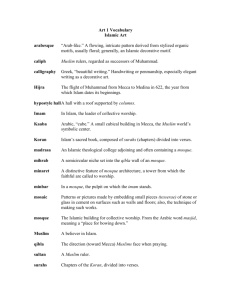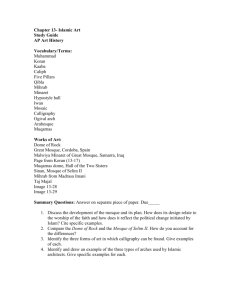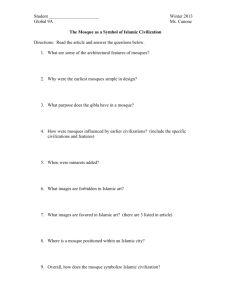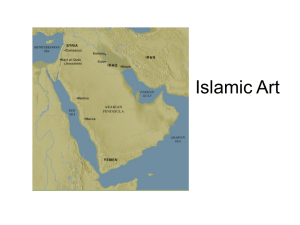GUIDED READING QUESTIONS: Islam Mr. Walker (APAH) NAME
advertisement
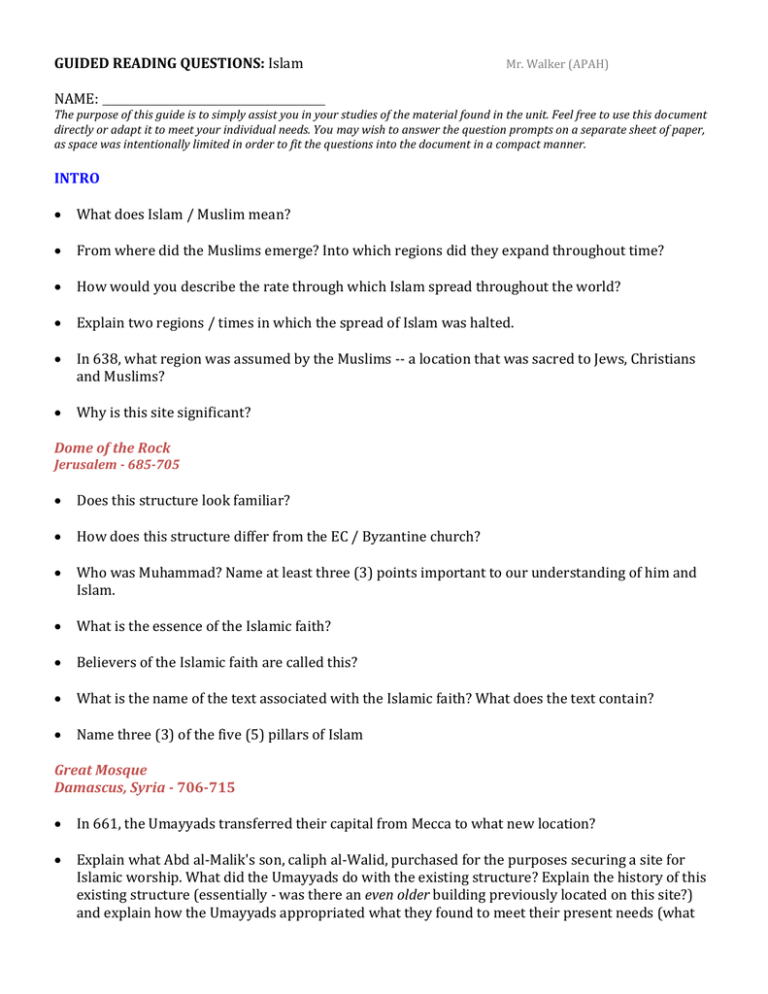
GUIDED READING QUESTIONS: Islam Mr. Walker (APAH) NAME: The purpose of this guide is to simply assist you in your studies of the material found in the unit. Feel free to use this document directly or adapt it to meet your individual needs. You may wish to answer the question prompts on a separate sheet of paper, as space was intentionally limited in order to fit the questions into the document in a compact manner. INTRO What does Islam / Muslim mean? From where did the Muslims emerge? Into which regions did they expand throughout time? How would you describe the rate through which Islam spread throughout the world? Explain two regions / times in which the spread of Islam was halted. In 638, what region was assumed by the Muslims -- a location that was sacred to Jews, Christians and Muslims? Why is this site significant? Dome of the Rock Jerusalem - 685-705 Does this structure look familiar? How does this structure differ from the EC / Byzantine church? Who was Muhammad? Name at least three (3) points important to our understanding of him and Islam. What is the essence of the Islamic faith? Believers of the Islamic faith are called this? What is the name of the text associated with the Islamic faith? What does the text contain? Name three (3) of the five (5) pillars of Islam Great Mosque Damascus, Syria - 706-715 In 661, the Umayyads transferred their capital from Mecca to what new location? Explain what Abd al-Malik's son, caliph al-Walid, purchased for the purposes securing a site for Islamic worship. What did the Umayyads do with the existing structure? Explain the history of this existing structure (essentially - was there an even older building previously located on this site?) and explain how the Umayyads appropriated what they found to meet their present needs (what was saved / demolished?). Create a list of the architectural elements found in the Islamic mosque which are modifications of preexisting Roman structures. This is a "hypostyle mosque" -- a type important, due to the fact that is best resembles what? Mosaic Detail – Great Mosque Damascus, Syria - 706-715 The mosaic detail, found within the interior of the Great Mosque, most likely represents the handiwork from what culture? The pictorial space of these mosaics, however, are devoid of what motifs? Umayyad Palace, Mshatta Jordan - ca. 740-750 Describe the architectural elements of this Palace which serve a protective role. Although this rural structure's condition is fragmented (at best), what have archeologists discovered in the ruins that tell us about the lasting influence that may have come from the Roman Empire? Frieze of the Umayyad Palace, Mshatta Jordan - ca. 740-750 Describe the manner in which the 16 foot tall stone frieze is decorated (technique, material, shapes present, compositional arrangement, terminology, motifs). What might be the cultural influences behind the treatment of this wall? What is decidedly unique, with respect to the manner in which the Islamic artists handled the treatment of the wall facade existing to the right of the portal (the part corresponding to the mosque's qibla wall? The Abbasids & Baghdad -- the hub of Arab power In 750, which incoming group overthrew the Umayyad caliphs? They relocated the new capital to Baghdad, calling it Madina al-salam. What does this translate to? In what year was the city laid out? How large was the capital and in what shape was it formed? What might be implied by this shape? For how long, beyond this point, did Baghdad serve as the hub of Arab power? Describe where the caliph's palace was located in this space and the manner in which it was oriented. How would you describe the relationship maintained between the Abbasid caliphs and the neighboring leaders throughout the world? Explain. Describe the relationship between the Abbasid caliphs and the artists during this time. Great Mosque (Kairouan, Tunisia) ca. 836-875 How large is the overall structure? How many columned aisles flank the left side of the nave? the right side of the nave? What does this imply about the function of this space? In your notes, make a drawing of the mosque, labeling it with the following features: o arcaded forecourt o hypostyle prayer hall o series of lateral entrances o entrance dome o qibla o qibla wall o forecourt o mihrab o mirhab dome o minaret Explain the manner in which the qibla wall (pron. KEY-blah) is oriented within a mosque structure. Why do carpets play an important role in Islamic art and life? Where would you find a mirhab? Explain the function of a mirhab. Describe a typical mirhab's form (aesthetic appearance). If you were to spend an entire day observing the interior space of a hypostyle prayer hall, describe what you might see. What is the function of a minaret? How many times might a minaret be used throughout a given day? Malwiya Minaret Samarra, Iraq - 848-852 Scholars think this minaret is a near copy of what? Why is this particular minaret notable / unique from any others? The term "malwiya" is an Arabic word which translates to what English word? Although it now stands alone, how did this structure once relate to the surrounding space? What material has been used to construct this minaret? What is the distinguishing feature found in this minaret? This structure was once mistaken for what Mesopotamian structure? What bearing did this have on some European artist's depictions of the Tower of Babel? Explain. What was the function of this particular minaret? Great Mosque - prayer hall Corduba, Spain - 8th-10th centuries Explain the situation in the Western end of Europe -- between the Christian kingdom of the Visigoths in 711 and Arabs. Who was Abd al Rahman I and why did he flee to Spain in the year 750? What did Rahman I do, after establishing himself in Spain? Where was the capital of the newly established Umayyad dynasty? What role did it play, with respect to the civilization of the Christian West? Explain the reasoning behind the unique system of double-tiered arches that exist in the mosque's prayer hall. How would you describe the shape / style of these arches. What does the visual treatment do to contribute to the overall "light and airy" feeling of the mosque's interior?
